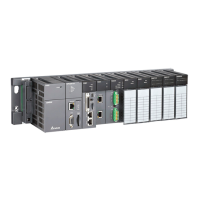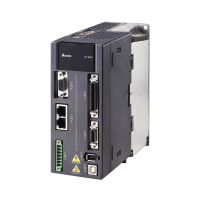Chapter 6 Applied Instructions
6-465
If the data in S~S+5 is -12345.678, the calculation is as follows.
b15
b0
b7 b8
0016#
S
+1
S
+2
S
+3
S
4
(D1+1,D1)
2D(-)16# 16#31(1)
32(2)16#
33(3)16#
35(5)16#
(4)16#34
2E(.)16#
-
1
3
5
36(6)16#
16#38(8)
37(7)16#
+4
S
+5 S
.
6
7
8
2
10
3
(D2+1,D2)
(D1+3,D1+2)
-12345678
If there is 16#20 or 16#30 between the sign character and the first value which is not 0 in the
string in S, 16#20 or 16#30 is ignored when the string is converted into the binary number.
12
2
-
123456
- 1234.56� ���
Ignored
Number of characters
Number of decimal places
Binary number
11
8
12345
0.00012345
Ignored
Number of characters
Number of decimal places
Binary number
Sign
If 16#2E, which represents the decimal point, is ignored, the string in S should be within the
range between -2147483648 and 2147483647. For example, if the string is “1234567.8”, users
have to check whether “12345678” is within the range.
4. If the sign code in S is 16#20, 16#2B, and 16#30 the conversion result is a positive value. If the
sign code in S is 16#2D, the conversion result is a negative value.
5. In the string in S, except for the sign code, the code representing the decimal point, and the
code which can be ignored, i.e. 16#20 or 16#30, the other codes have to be within the range
between 16#30 and 16#39.
Example 1:
b15
b0
b7 b8
0016#
D20
2D(-)16# 16#31(1)
32(2)16# 2E(.)16#
34(4)16#
33(3)16#
2
6
-1234
D21
D22
D23
D10 ( )Number of characters
D11 ( )Number of decimal places
D0

